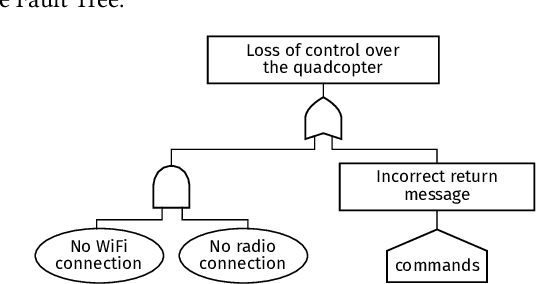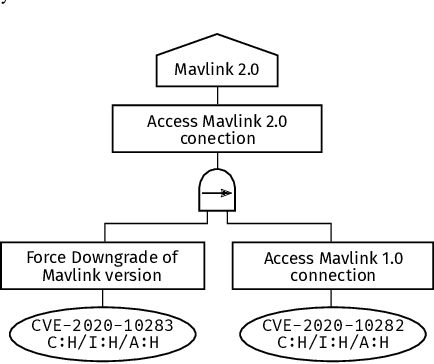Irdin Pekaric
Streamlining Attack Tree Generation: A Fragment-Based Approach
Oct 01, 2023



Abstract:Attack graphs are a tool for analyzing security vulnerabilities that capture different and prospective attacks on a system. As a threat modeling tool, it shows possible paths that an attacker can exploit to achieve a particular goal. However, due to the large number of vulnerabilities that are published on a daily basis, they have the potential to rapidly expand in size. Consequently, this necessitates a significant amount of resources to generate attack graphs. In addition, generating composited attack models for complex systems such as self-adaptive or AI is very difficult due to their nature to continuously change. In this paper, we present a novel fragment-based attack graph generation approach that utilizes information from publicly available information security databases. Furthermore, we also propose a domain-specific language for attack modeling, which we employ in the proposed attack graph generation approach. Finally, we present a demonstrator example showcasing the attack generator's capability to replicate a verified attack chain, as previously confirmed by security experts.
Towards Model Co-evolution Across Self-Adaptation Steps for Combined Safety and Security Analysis
Sep 18, 2023



Abstract:Self-adaptive systems offer several attack surfaces due to the communication via different channels and the different sensors required to observe the environment. Often, attacks cause safety to be compromised as well, making it necessary to consider these two aspects together. Furthermore, the approaches currently used for safety and security analysis do not sufficiently take into account the intermediate steps of an adaptation. Current work in this area ignores the fact that a self-adaptive system also reveals possible vulnerabilities (even if only temporarily) during the adaptation. To address this issue, we propose a modeling approach that takes into account the different relevant aspects of a system, its adaptation process, as well as safety hazards and security attacks. We present several models that describe different aspects of a self-adaptive system and we outline our idea of how these models can then be combined into an Attack-Fault Tree. This allows modeling aspects of the system on different levels of abstraction and co-evolve the models using transformations according to the adaptation of the system. Finally, analyses can then be performed as usual on the resulting Attack-Fault Tree.
Simulation of Sensor Spoofing Attacks on Unmanned Aerial Vehicles Using the Gazebo Simulator
Sep 18, 2023



Abstract:Conducting safety simulations in various simulators, such as the Gazebo simulator, became a very popular means of testing vehicles against potential safety risks (i.e. crashes). However, this was not the case with security testing. Performing security testing in a simulator is very difficult because security attacks are performed on a different abstraction level. In addition, the attacks themselves are becoming more sophisticated, which directly contributes to the difficulty of executing them in a simulator. In this paper, we attempt to tackle the aforementioned gap by investigating possible attacks that can be simulated, and then performing their simulations. The presented approach shows that attacks targeting the LiDAR and GPS components of unmanned aerial vehicles can be simulated. This is achieved by exploiting vulnerabilities of the ROS and MAVLink protocol and injecting malicious processes into an application. As a result, messages with arbitrary values can be spoofed to the corresponding topics, which allows attackers to update relevant parameters and cause a potential crash of a vehicle. This was tested in multiple scenarios, thereby proving that it is indeed possible to simulate certain attack types, such as spoofing and jamming.
VULNERLIZER: Cross-analysis Between Vulnerabilities and Software Libraries
Sep 18, 2023



Abstract:The identification of vulnerabilities is a continuous challenge in software projects. This is due to the evolution of methods that attackers employ as well as the constant updates to the software, which reveal additional issues. As a result, new and innovative approaches for the identification of vulnerable software are needed. In this paper, we present VULNERLIZER, which is a novel framework for cross-analysis between vulnerabilities and software libraries. It uses CVE and software library data together with clustering algorithms to generate links between vulnerabilities and libraries. In addition, the training of the model is conducted in order to reevaluate the generated associations. This is achieved by updating the assigned weights. Finally, the approach is then evaluated by making the predictions using the CVE data from the test set. The results show that the VULNERLIZER has a great potential in being able to predict future vulnerable libraries based on an initial input CVE entry or a software library. The trained model reaches a prediction accuracy of 75% or higher.
 Add to Chrome
Add to Chrome Add to Firefox
Add to Firefox Add to Edge
Add to Edge